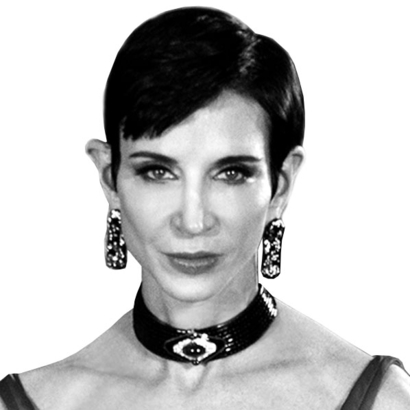All cinemas, theatres, concert halls and other public venues were ordered to close … people were discouraged from gathering in large numbers … every member of the public had to carry a gas mask …
These words, which could describe New York City in the spring of 2020, in fact portray London, circa 1939 to 1940, during the period of the Phony War. This was also the backdrop for Audrey Withers’s unlikely ascension to her 20-year reign as British Vogue’s editor, a saga recounted in fine detail by Julie Summers in her new biography, Dressed for War.
Brought up in Gloucestershire and Oxfordshire, Withers, a cultured, quirky bibliophile, never had ambitions to take on the fashion world. Among her doctor father’s close friends were the Surrealist painter Paul Nash and the engraver Maur Griggs, who helped Audrey, after her 1927 graduation from Somerville College, Oxford, to land a job at a London bookshop. There she met a rogue named Jock Stewart, to whom she stayed unhappily married for nearly 20 years.

In 1931, the 26-year-old Withers answered an Evening Standard want ad for an entry-level position at an unnamed fashion magazine. The publication turned out to be British Vogue, and in spite of her indifference to fashion (Withers was toothy, tall, and tidy rather than chic), she was hired. Her assiduousness and flair for writing and editing did not go unnoticed. In 1935, editor in chief Betty Penrose promoted Withers to managing editor. Prior to her advancement, Penrose advised Mr. Condé Nast, her boss in New York, “I do not feel you could ever quite replace her.”
Trading Places
Withers could, however, replace Penrose. An American, Penrose set sail for New York in June 1940 to visit her family and ended up staying there for the duration of the war. Withers, by now 35, officially took over as editor in chief in September 1940—right at the start of the Blitz. Undaunted, Withers met the situation head on, “bringing out issue after issue, usually on time, in the teeth of bombs,” Condé Nast boasted to advertisers. Rather than evacuating Vogue’s offices at One New Bond Street (twice damaged during air raids), the unflappable Withers routinely shepherded her staff into the basement to conduct business as usual.
Their activities down in the cellar were far from frivolous. Aiming to influence women’s thinking—about rationing, morale, food, and volunteer work—the War Office, the Board of Trade, and the Ministry of Information all relied on Withers and her counterparts at other women’s magazines (combined, their periodicals reached more than 90 percent of British women) to disseminate their messages. So great was her zeal, Withers (nicknamed “Austerity Withers”) did her part for the paper shortage by pulping the entire pre-1942 archive of British Vogue, including its collection of Cecil Beaton’s photographs and drawings.

While combing through the 900 memos exchanged between Withers and Edna Woolman Chase, American Vogue’s venerable editor (their missives are preserved in Condé Nast’s New York archives), Summers discovered that Beaton’s most admired photograph of the period had in fact been Withers’s own brainchild. Titled Fashion Is Indestructible and published in September 1941, the picture shows model Elizabeth Cowell in a Digby Morton suit standing among the firebombed ruins of the 12th-century Temple Church, just down the street from the simultaneously blasted Vogue patterns factory.
Withers met the war head on, “bringing out issue after issue, usually on time, in the teeth of bombs.”
Withers’s most inspired collaboration with a photographer-writer, however, was not with Beaton but with his younger rival, Lee Miller. Under Withers’s watch, the erstwhile glamour girl metamorphosed into an almost preternaturally heroic war correspondent. In August 1944, while embedded with the American 83rd Infantry during the siege of St. Malo, Miller snapped for Vogue the terrifying explosions of the U.S.’s brand-new secret weapon: napalm. Even more extraordinary, the former mannequin was on the scene in April 1945 when the Americans liberated Buchenwald and Dachau. Miller dispatched her ghastly photos back to Withers with a cable exhorting her to “BELIEVE THAT THIS IS TRUE.”

British Vogue, whose circulation during wartime had risen to one million readers, thrived under Withers’s stewardship afterward, as well. A collector of modern art and ideologically egalitarian, Withers commissioned from Irving Penn his masterly “Small Trades” series for Vogue’s February 1951 “Britannica” issue. Presciently, she brought fashion broadcasts to the novel medium of television, and in 1953, as a result of her advisory role in Queen Elizabeth II’s coronation, she was awarded an O.B.E. In a long-overdue move, Withers divorced Jock, replacing him with Victor Kennett, a Russian with whom she had had an affair many years earlier. That much-deferred alliance should have given Withers’s post-Vogue story a happily-ever-after ending. But when, in 1960, Withers exchanged her Vogue post for a pastoral life with Kennett in Essex, her chronic backaches became so debilitating that, assuming her pain was imaginary, he had her committed to a mental institution. During her widowhood and onward into her 90s, the redoubtable journalist whom Summers maintains was “once the most powerful woman in London” found a new calling as a rank-and-file volunteer for the Social Democratic Party.
Though her research is exemplary, Summers leaves one tantalizing stone unturned. Immediately after the war, French Vogue’s editor, Michel de Brunhoff, sent Withers a confidential report identifying precisely which fashion houses and which couturiers had been Nazi collaborators. Withers then had the memo forwarded to all of Condé Nast’s New York editors. If, as she implies, Summers saw this document, it is high time for it to be declassified.
Amy Fine Collins is an Editor at Large for Air Mail and a Special Correspondent for Vanity Fair. She lives in New York City


